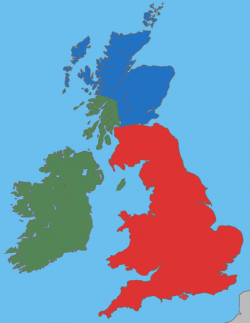Prydain
Prydain is the medieval Welsh term for the island of Britain (the name Albion was not used by the Welsh). More specifically, Prydain may refer to the Brittonic parts of the island; that is, the parts south of Caledonia. This distinction appears to derive from Roman times, when the island was divided into Roman Britain to the south and the land of the Caledonians to the North. The peoples north of the Roman borders eventually came to be known as the Picts (Welsh: Brithwyr); the Welsh term for Pictland was Prydyn, which caused some confusion in the texts with Prydain.
In Middle Welsh texts, the related term Ynys Prydein (Island of Britain), or Ynys Brydein, can also refer to the island (ynys) itself but more often is a name for the Brittonic territories south of Caledonia. It is in this context that the name of the collection of traditional material arranged in triads known as Trioedd Ynys Prydein should be understood. In modern Welsh ynys means 'island', but in Middle Welsh it can also mean 'land' or 'realm' (cf. Latin insula).
Post-Roman Britain Culturally, the people of Prydain are closer to their Celtic forebears than the Normanized Britons of Malory and the Vulgate. Their political organization is more tribal than feudal, especially after the departure of the Roman Empire. This occurred much more recently in the real Britain than in myth; many Britons were still "Romanized," that is, living and thinking as Romans. For a long time, they were at the core of what little central government survived. Ambrosius Aurelianus briefly reorganized them to help repel the Saxons, but as a separate cultural group they lasted only a few decades.
Once Rome departed, the ancient Celtic clans and tribes began to reassert themselves. This was in part due to clan-linked defensive plans established by early generals. Left to itself, Britain might have returned entirely to a clan/tribe system, but something intervened. As a result of a bungle by Vortigern, the Saxon invasions began. Britain halted midway in its slide back to barbarism to repel even more barbarous invaders. The Roman-based organization of Britain held, even under the slipshod leadership of the various clan heads.
Even so, there were subdivisions. The seeds of modern Wales were planted at this time, in the region known as Powys. Cornwall was developing in Dumnonia. And the beginnings of Scotland were burgeoning north of Hadrian's Wall in Galloway, Bernicia and Manau Gododdin. Northumbria, Mercia and Essex made up the land that in myth would become Logres, but was at this time just the home of Britons.
Little is known about the politics of the period, but the existence of an effective High King shows that united action was not only conceivable but frequent. It seems reasonable that some sort of council may have existed, a descendant in spirit of the Roman-style civitates. But the High King's ability to call up thousands of troops and engage in military action unilaterally indicates a high level of autonomy and political power. Very likely the High King was truly an absolute ruler.
Technology
Britain in the 5th century is not particularly advanced. Its technical development is based directly on Rome's. Fortunately, enough craftsmen remained after the departure of the Legions for Britain to maintain TL2.
The science breakdowns are as follows:
British Tribal Society
Underlying the Roman culture imposed on Britain was the original Celtic tribal structure. When the Empire's hold on the island loosened, the tribes underwent a great resurgence. Eventually, as a result of the Saxon threat and other influences, the burgeoning tribes and the remaining Romanized state entered a certain equilibrium.
Transportation
This is as listed in the chart on p. B185. Although saddles had been developed, stirrups were non-existent; lance-users as found in the mythic Arthur are impossible. Roman-style galleys were in abundance, or could be manufactured at will, as evidenced by the creation of a navy by Riothamus and Ambrosius.
Weapons and Armor
The only available armor forms in Britain are very different from the Roman styles which had preceded them: simple leather jerkins, and scale mail using bronze scales over a leather coat. Bronze or iron helms styled somewhere be tween the standard GURPS pot-helm and great-helm were also used. Medium shields were used on horseback, and medium or large shields on foot. A few pieces of Roman plate or chain may be in the hands of upper-class Britons. A variety of swords were available; Roman-style shortswords may have been most common, but there is some evidence that broadswords were already
Mapping
For flavor, below is the absolutely insane manner in which a Roman map of the time would show England. I have no intention of using something this crazy but it certainly explains some things about that era...

